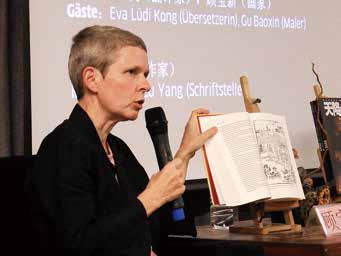Eva Luedi Kong: Journey to the East
2019-01-11YuJingjing
Yu Jingjing

林小發在介绍德语版《西游记》。Eva Luedi Kong talks about the German edition of Journey to the West at a cultural event.
Swiss sinologist Eva Luedi Kongs German translation of Chinese classical novel was launched onto market in 2016 and won her Leipzig Book Fair Prize in 2017. In October 2018, she published a German translation of the , a Chinese poem that has been used as a primer for teaching Chinese characters to children from the sixth century onward. It contains exactly one thousand characters, each used only once, arranged into 250 lines of four characters apiece and grouped into four line rhyming stanzas to make it easy to memorize. It is sung in a way similar to children learning the Latin alphabet sing an “alphabet song.” Along with the and the , it formed the basis of literacy training in traditional China.
Unlike the publishing of , which she spent 17 years translating and polishing and was turned down many times by publishers, this text took her about half a year to complete translating and a publisher was glad to take it up.
But she ran into by accident at a weekend secondhand book market in the courtyard of Zhejiang Library many years ago just like she picked up accidently in a secondhand bookstore in Shanghai. The book had stayed on her bookshelf for a long while until one day in 2017 she happened to see the book again and decided to give it a go. She read it and found the text fascinating and decided to translate it into German. She thought the text of rhyming stanzas was full of images as portrayed in the traditional Chinese language. She found it challenging to render the vivid descriptions into modern German which focuses on being logical, precise and thorough.
She did not run into so many difficulties this time. First of all, it was a primer for children in traditional China. Second, she is more than what she was 20 years ago. When she first spotted an annotated edition of from the 17th-century at a secondhand bookstore in 1998 in Shanghai, she knew not so much about Chinese as well as Chinese culture, religion, history, etc. Back home she studied Taoism and Buddhism for about half a year before she went back to the bookstore and bought the book. Shortly after the start of her 17-year translation odyssey, she came back to China in 2000 and enrolled in a Masters program in classical Chinese literature at Zhejiang University. What she learned facilitated her translation.
Years ago she began to seek a publisher for the with an incomplete manuscript. This unfinished work didnt help her very much, let alone the unknown reputation of the Chinese classical novel.
What helped her German version of readily acceptable this time was that she provided a complete translation as well as a complete design. She literarily designed the layout of the book. The ingenious form she adopted for the book is quite fascinating. For each character, there is a short line of German words. So a four-character piece in the Chinese is a short and clean-cut four-line stanza in German. The original Chinese character is kept with Pinyin so that the German reader can peep into the original Chinese text as it is.
After the release of the translation onto market, Frankfurter Allgemeine Zeitung (Frankfurt General Newspaper), recommended it for holiday reading. It is the German newspaper with the widest circulation abroad, with its editors claiming the newspaper is delivered to 148 countries.
